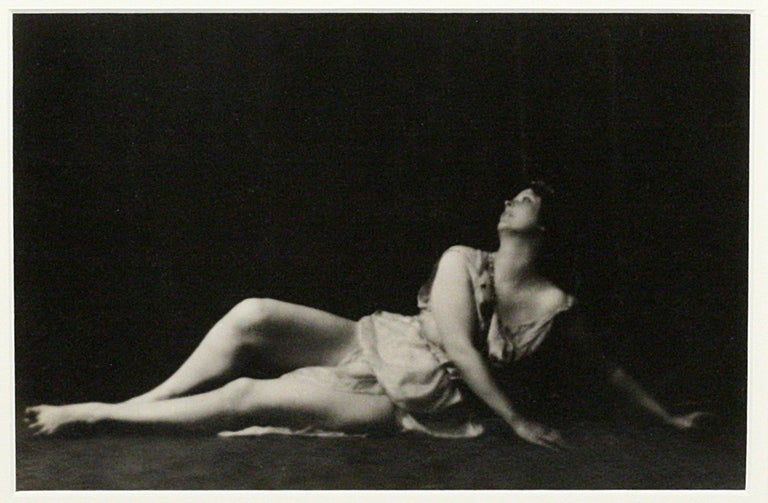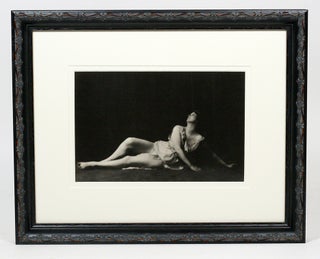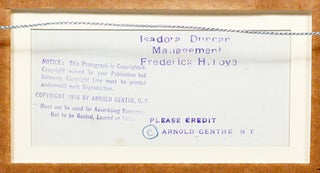Silver Print Photograph
“When we reached New York... [b]y chance I called up a great friend, Arnold Genthe. He is not only a genius but a wizard. He had left painting for photography, but this photography was most weird and magical. It is true he pointed his camera at people and took their photographs, but the pictures were never photographs of his sitters but his hypnotic imagination of them. He has taken many pictures of me which are not representations of my physical being, but conditions of my soul, and one of them is my very own soul indeed.” -Isadora Duncan, My Life
EXQUISITE ICONIC PHOTOGRAPH OF ISADORA DUNCAN BY ARNOLD GENTHE.
“In the early 20th century, a new form of dance was emerging, one fostered by periods of experimentation in European cities and transferred to American stages by impassioned personalities led by Isadora Duncan. As this new, modern dance both challenged and influenced other dances from ballet to vaudeville, the lines between these forms became blurred allowing for a cacophony of creative expression. The dance world was expanding and changing in a myriad of ways, and nowhere was that more evident than in New York City, where high and low dance shared the same urban space and exchanged ideas and inspiration. Modern dance, as with other modernist movements of the time, sought new forms with which to express the spirit of modern times, and as Duncan phrased it, to express ‘the free spirit, who will inhabit the body of the new woman; more glorious than any woman that has yet been… the highest intelligence in the freest body.’
“As modern dance developed and evolved, dance photography also began to develop, influenced by photographer Arnold Genthe (1869-1942), who utilized his signature style to capture dancers ‘in the free movement of the dance.’ ... Genthe avoided posed photographs, choosing to capture his subjects in an unobtrusive manner, the better to express the essence of a human being. This same principle he applied to his dance photography. Here it was not just the soul and spirit of the dancer he sought to capture, but the motion of the dance, those ‘fleeting magic designs made by the human body.’ Genthe’s goal was to create an image that suggested both the ‘proceeding as well as the following movement,’ that suggested motion, ‘fluent, dynamic, natural.’
“In his memoir, Genthe spent several pages discussing the difficulty of photographing this ephemeral art form adequately, claiming that very few of his pictures do dance justice, even those published in the 1916 volume The Book of the Dance. However, he is considered one of the pioneers in the field of dance photography, and his images include some of the leading participants in early modern dance, including Isadora Duncan, Ruth St. Denis, and Anna Pavlova...
“Lauded as the ‘Mother of Modern Dance,’ Isadora Duncan (1877-1927) challenged established forms of dance through an emphasis on expressing the human spirit through movement. She performed throughout Europe and America and became a popular symbol and subject for modernists and artists. Photographed in New York between 1915 and 1918, Genthe was originally commissioned to take only a passport photo, but Duncan was so enraptured with the photograph and his style she had him take several more photographs of her and her dancers. As Duncan wrote in her autobiography My Life, his ‘pictures were never photographs of his sitters but his hypnotic imagination of them. He has taken many pictures of me which are not representations of my physical being but representations of conditions of my soul.’ These photographs have since become some of the most famous made of Duncan...” (Maureen Maryanski, “Fleeting Magic Designs”: Arnold Genthe and the Dance, New York Historical Society).
With Genthe’s copyright stamps (with noted restrictions) and stamp of Duncan’s manager Frederick H. Toye on verso.
Size: Photograph = 5.75 x 8.5 inches. Archivally framed under UV-protecting museum glass to an overall size of 12x15 inches.
New York: Arnold Genthe, 1916. Nearly fine, with only a very mild crease and edge silvering visible in raking light. A beautiful image perfectly uniting photographer and subject.
.
Price: $2,900 .




